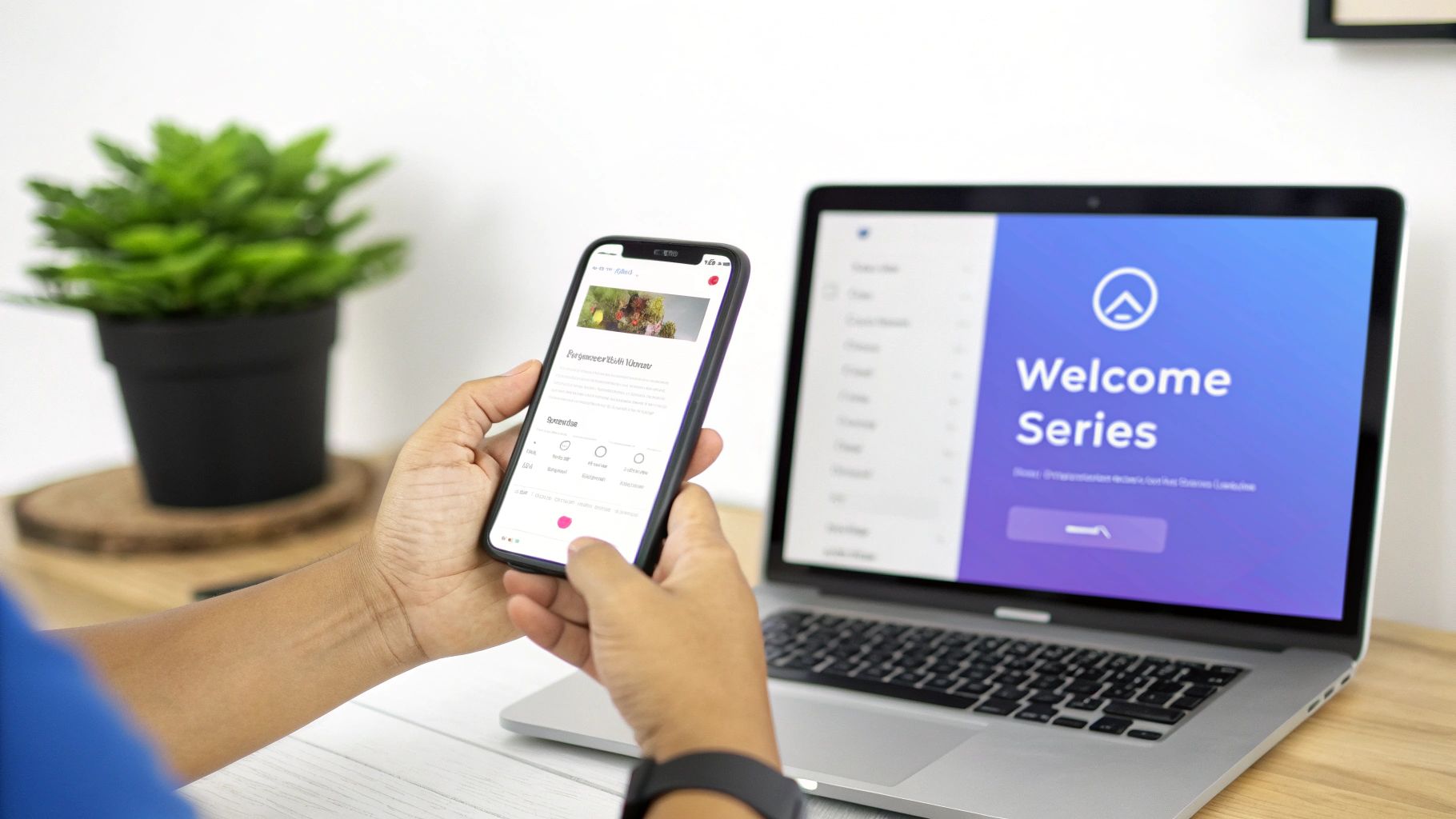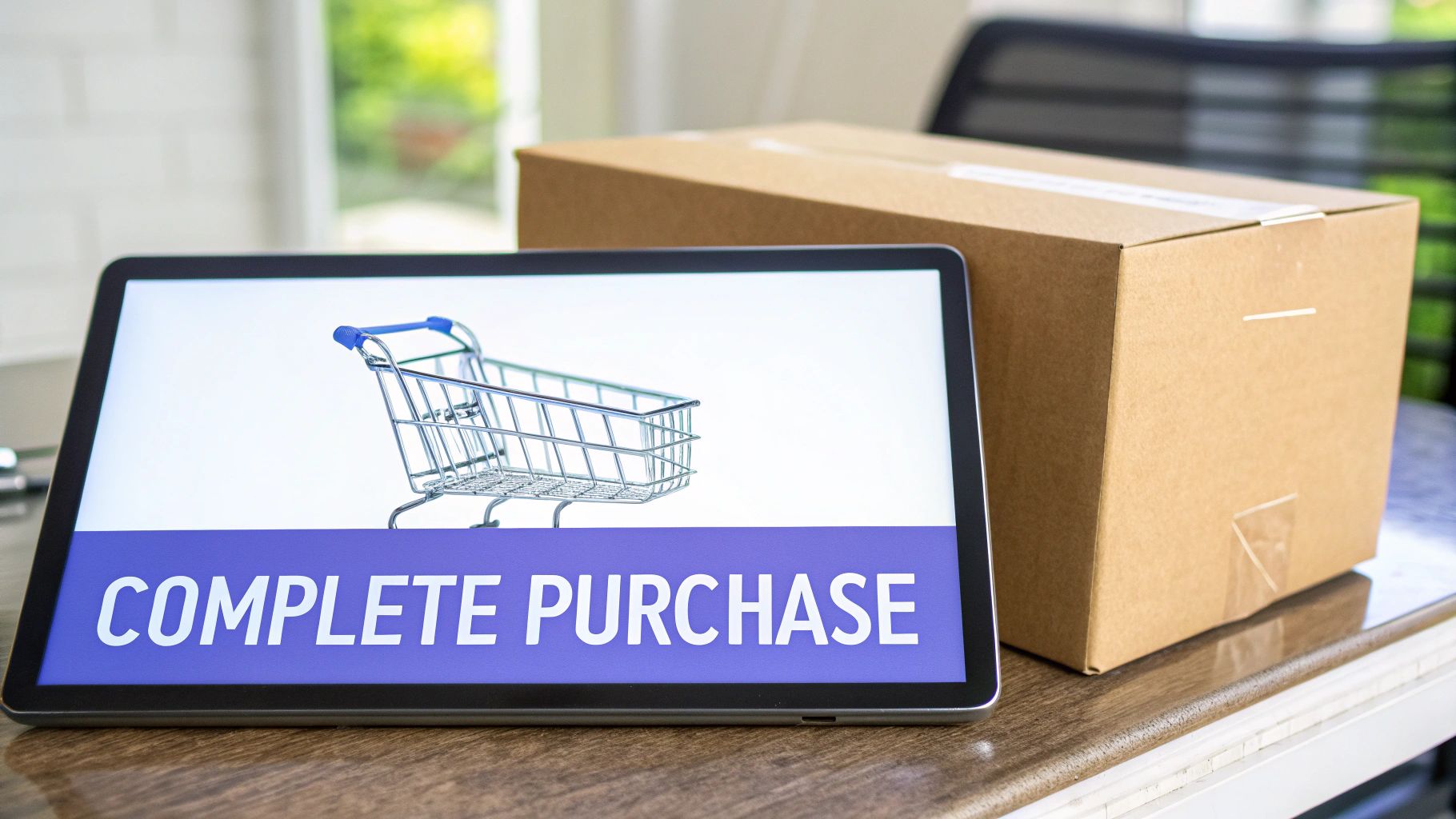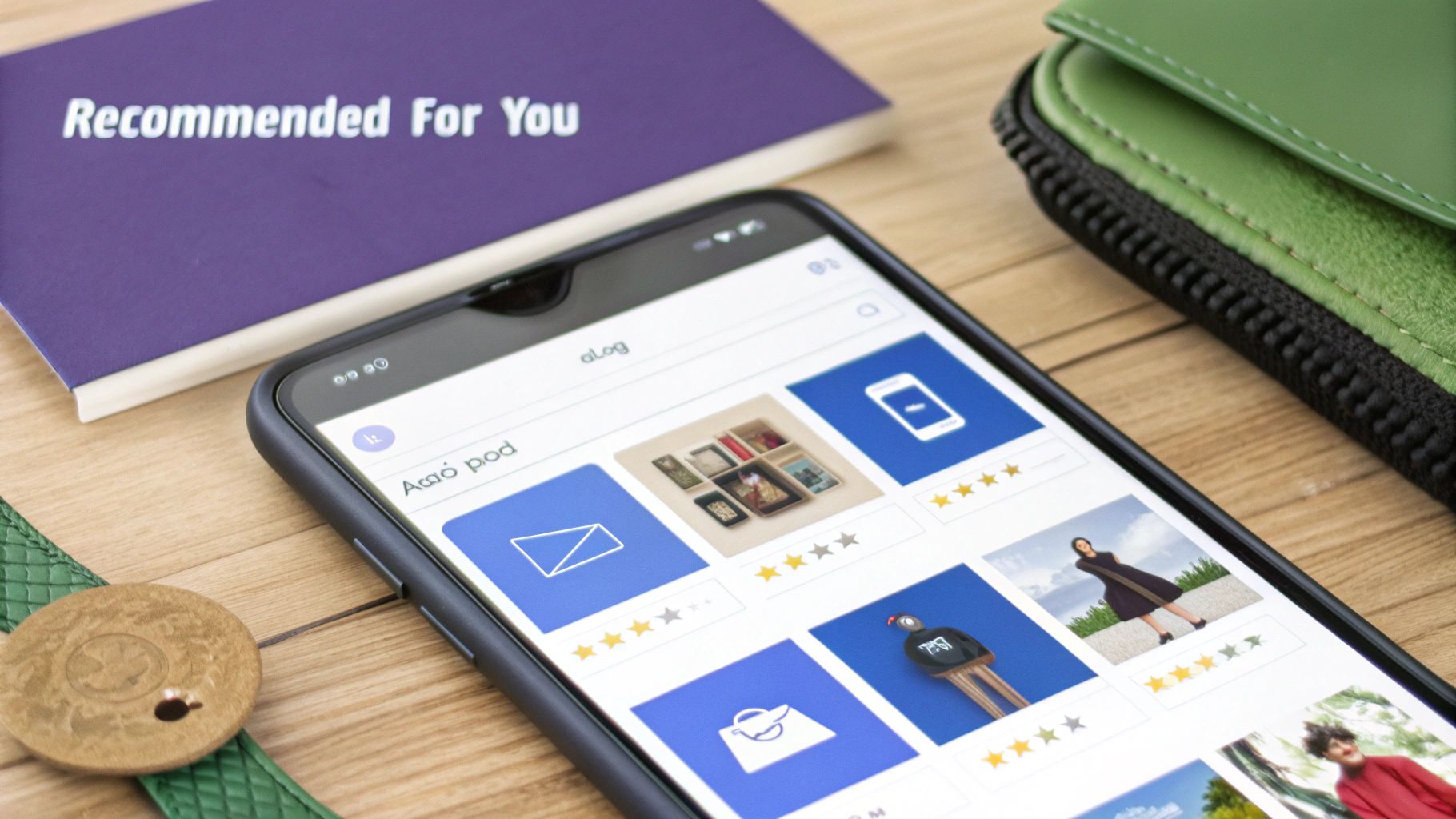Discover 10 powerful examples of marketing emails that actually work. See real-world breakdowns to boost your open rates, clicks, and revenue today.
Email marketing delivers an average ROI of $36 for every $1 spent according to HubSpot, but most emails are deleted in seconds. The difference between a deleted email and a converted lead isn't just good copy; it's a strategic framework. This guide moves beyond generic templates to dissect 10 powerful examples of marketing emails, revealing the specific tactics and psychological triggers that drive action.
Drawing on insights from platforms like HubSpot and proven RevOps methodologies, we'll break down precisely what makes these emails work. Are you ready to stop guessing and start building a predictable revenue engine? You're about to learn the exact structure, timing, and metrics that B2B SaaS leaders use to transform their email list from a simple contact database into a powerful growth asset.
We'll provide actionable frameworks you can implement immediately, backed by data showing what is effective right now. Instead of just showing you a collection of pretty emails, we'll teach you the ‘why’ behind their success. This analysis is designed to help you shift your strategy from guesswork to a data-driven science, equipping you with the tools to build campaigns that not only engage but consistently convert. Let’s explore the anatomy of emails that generate real pipeline value.
1. Welcome Series Email
A welcome series is your first, and most crucial, conversation with a new subscriber. It's an automated sequence of 3-5 emails sent immediately after sign-up, designed to onboard them effectively. This initial interaction is where you set the tone for the entire customer relationship, introduce your brand's value, and guide them toward their first "aha!" moment. It's one of the most powerful examples of marketing emails because it capitalises on the moment of highest engagement, when a user has just actively shown interest in your brand. In fact, welcome emails can generate up to 320% more revenue per email than other promotional emails, as reported by Invesp.

Welcome Series Email
Strategic Breakdown
Companies like Slack excel at this. Their welcome series isn't just a greeting; it's a mini-tutorial that demonstrates immediate value. Each email focuses on a core feature, guiding new users on how to get started, create channels, and invite team members. This educational approach reduces friction and accelerates user activation, turning a sign-up into an engaged user. For a B2B SaaS audience, this is fundamental for showcasing product value from day one. Proper onboarding is also a key component of successful marketing initiatives, and you can learn more about improving sales and marketing alignment here.
Actionable Takeaways
- •Send Immediately: Trigger the first email within five minutes of sign-up to maintain momentum.
- •Set Expectations: Clearly state what kind of content they will receive and how often.
- •Show, Don't Just Tell: Use GIFs or short video links to demonstrate key features in action.
- •Focus on One Goal Per Email: Dedicate each email to a single, clear action, like "Complete Your Profile" or "Create Your First Project."
2. Promotional/Sales Email
Promotional or sales emails are the workhorses of direct-response marketing. These are targeted messages designed to drive immediate action, such as a purchase or sign-up, by announcing special offers, discounts, or new product launches. By leveraging tactics like urgency and scarcity, these emails aim to convert interest into revenue quickly. They represent one of the most direct examples of marketing emails, as their success is measured almost entirely by conversion rates and sales figures.
Strategic Breakdown
Retail giants like Amazon have perfected the promotional email with their 'Lightning Deals'. These communications are models of efficiency, featuring a clear product, a significant discount, and a countdown timer to create a powerful sense of urgency. The goal is to short-circuit the customer's consideration phase and prompt an impulse purchase. This strategy is highly effective because it focuses on a single, compelling offer and removes friction from the buying process. A well-crafted campaign can generate a significant revenue spike in just a few hours. For a deep dive into campaign creation, you can explore more about running effective email and ad campaigns here.
Actionable Takeaways
- •Create Urgency: Use action-oriented subject lines like "Last Chance: 40% Off Ends Tonight" and include countdown timers in the email body.
- •Keep It Scannable: Present your offer clearly and concisely. Use bold text for the discount and bullet points for key benefits.
- •Have a Singular Focus: Dedicate the entire email to one primary offer and a single, unmissable call-to-action (CTA) button.
- •Test Your Offers: A/B test different incentives. Some audiences might respond better to "Free Shipping" than to "20% Off," even if the monetary value is lower.
3. Abandoned Cart Email
An abandoned cart email is a crucial automated follow-up sent to shoppers who add products to their online cart but leave without completing the purchase. This timely reminder serves to re-engage potential customers at a high-intent moment, aiming to recover what would otherwise be lost revenue. For e-commerce and even some B2B SaaS models with self-serve options, this is one of the highest ROI examples of marketing emails you can implement, directly impacting conversion rates. According to Klaviyo, businesses using abandoned cart emails recover 3-14% of lost sales on average.

Abandoned Cart Email
Strategic Breakdown
Brands like Target and Etsy have mastered this process. Their abandoned cart emails are not just reminders; they are personalised, helpful nudges that overcome common purchase barriers like distraction or price uncertainty. They often include images of the exact items left behind, customer reviews to build trust, and a clear, compelling call-to-action to "Return to Your Cart." This strategy effectively shortens the consideration phase by reminding users of the value they saw in the product, making it easy for them to finalise their decision.
Actionable Takeaways
- •Act Quickly: Send the first email within one hour of cart abandonment to stay top-of-mind.
- •Create a Sequence: Develop a series of 2-3 emails sent over a few days, with each message offering a new angle or a slightly stronger incentive.
- •Showcase Social Proof: Include star ratings or a snippet from a positive customer review directly in the email to build confidence.
- •Offer a Smart Incentive: Instead of an immediate discount, consider offering free shipping in a later email, which often has a higher perceived value and protects your margins.
4. Newsletter Email
A newsletter is a recurring, content-driven email sent to subscribers at a regular interval. Unlike purely promotional sends, its primary goal is to build a relationship and establish authority by consistently delivering value. It keeps your brand top-of-mind by offering curated industry insights, company news, and expert commentary. This makes it one of the most sustainable examples of marketing emails, transforming your mailing list from a sales channel into a loyal community.
Strategic Breakdown
Media companies like Morning Brew have built entire empires on the back of the newsletter format. They provide digestible, witty summaries of business news that save their audience time while keeping them informed. For a B2B SaaS company, this strategy is highly effective for nurturing leads who aren't yet ready to buy. By providing valuable content without a hard sell, you position your brand as a trusted advisor, making it the natural choice when a purchasing need arises.
Actionable Takeaways
- •Establish a Cadence: Choose a consistent schedule (weekly, bi-weekly) and stick to it to build anticipation and habit.
- •Follow the 70/30 Rule: Ensure your content is 70% valuable and educational, and only 30% promotional to maintain reader trust.
- •Develop a Distinctive Voice: Use a conversational, human tone, not corporate jargon. Let your brand's personality shine through.
- •Curate, Don't Just Create: Mix original content with links to valuable third-party resources to become a go-to source of information in your niche.
5. Re-engagement/Win-back Email
A re-engagement or win-back campaign is a strategic, automated email sequence sent to inactive subscribers who have stopped opening, clicking, or converting. Rather than letting these contacts decay, this campaign attempts to rekindle their interest before they are removed from your list for good. It is a critical example of marketing emails focused on list hygiene and maximising the value of every acquired lead. By specifically targeting disengaged users, you can either reactivate their interest or cleanly prune your list to improve overall deliverability and engagement metrics.
Strategic Breakdown
Companies like Spotify and Netflix use this tactic effectively by combining a touch of nostalgia with a compelling offer. A classic "We miss you" email from Spotify might showcase what the user has missed or offer a special discount on a premium subscription. This approach works because it acknowledges the user's absence directly and provides a clear, low-friction path back to engagement. For a B2B SaaS company, this could mean offering a one-on-one demo of new features or a discount on their next billing cycle, turning a potential churn risk into a re-engaged customer. Performing regular list maintenance is vital for success, and you can learn more about conducting a CRM audit and improving data hygiene here.
Actionable Takeaways
- •Segment by Inactivity: Create segments based on the last open date (e.g., 60, 90, or 180 days) to tailor your message.
- •Use a Direct Subject Line: Honest subject lines like "Is this goodbye?" or "A special offer to win you back" often perform best.
- •Offer a Powerful Incentive: A standard 10% discount won't cut it. Consider offering a significant value proposition, like 25-40% off or a free upgrade.
- •Ask for Feedback: Include a simple one-click survey asking why they've been inactive to gather valuable customer insight.
6. Product Recommendation Email
A product recommendation email uses customer data to suggest items they are highly likely to purchase. By analysing browsing history, previous purchases, and even user preferences, these automated emails deliver a hyper-personalised shopping experience directly to the inbox. This strategy transforms a generic broadcast into a curated, one-to-one conversation, dramatically increasing relevance and conversion rates. Leveraging data this way makes it one of the most effective examples of marketing emails for e-commerce and streaming services alike.

Product Recommendation Email
Strategic Breakdown
Companies like Amazon and Stitch Fix have mastered this approach. They move beyond simple "people also bought" logic by employing sophisticated collaborative filtering and machine learning models. Stitch Fix, for example, combines AI with human stylists to send curated clothing selections, turning a recommendation into a full-service experience. This demonstrates a deep understanding of individual taste, making customers feel seen and valued, which in turn fosters significant brand loyalty and repeat business. For any business with a diverse product catalogue, this is a powerful tool for driving discovery and increasing average order value.
Actionable Takeaways
- •Leverage Purchase History: Prioritise recommendations based on what a customer has actually bought, not just browsed.
- •Limit the Choices: Present a curated selection of 4-6 items to avoid overwhelming the recipient.
- •Incorporate Social Proof: Include customer ratings, reviews, or labels like "Frequently Bought Together" to build trust.
- •Use a Clear Call-to-Action: Make each recommended product clickable with a straightforward CTA like "Shop Now" or "View Details."
7. Event Invitation/Announcement Email
Event invitation emails are time-sensitive communications designed to drive registrations for webinars, conferences, product launches, or exclusive workshops. They are more than just a calendar invite; they are a critical tool for building anticipation, demonstrating value, and securing attendee commitment. These campaigns are powerful examples of marketing emails because they use urgency and exclusivity to prompt immediate action, converting subscriber interest into direct participation and engagement with your brand.
Strategic Breakdown
Companies like HubSpot master the event invitation by treating it as a multi-stage campaign, not a single email. They build a narrative around the event, starting with a "save the date" teaser, followed by emails detailing the agenda, speaker bios, and unique benefits for attendees. This sequenced approach builds momentum and addresses different audience motivations over time. For a B2B SaaS audience, clearly articulating "what's in it for me" with specific learning outcomes or networking opportunities is crucial for driving registrations and ensuring high-quality attendance.
Actionable Takeaways
- •Create a Multi-Touch Cadence: Plan a sequence including an initial announcement (3-4 weeks out), a reminder (1 week out), and a final "last chance" email (24-48 hours before).
- •Clearly State the Value: Use bullet points to highlight the key takeaways, agenda items, and who the event is for.
- •Feature Your Speakers: Include professional headshots and brief, compelling bios for your speakers to build credibility and humanise the event.
- •Simplify Registration: Use a bold, prominent Call-To-Action (CTA) button that leads directly to a frictionless registration page.
8. Customer Feedback/Survey Email
A customer feedback or survey email is a direct request for a customer's opinion on a product, service, or overall experience. Sent after a key interaction, such as a purchase or support ticket resolution, its goal is to gather actionable data. These insights are invaluable for product development, service improvements, and gauging brand health. This is one of the most vital examples of marketing emails because it transforms a simple transaction into a two-way conversation, making customers feel heard and valued.
Strategic Breakdown
Companies like Airbnb master the post-experience survey. Their emails are timely, personalised, and frame the request as a way to help the community, not just the company. By asking for a review shortly after a guest checks out, they capture feedback when the experience is fresh. For a B2B SaaS company, this could manifest as a Net Promoter Score (NPS) survey sent after 90 days of use. This data directly informs the product roadmap and identifies both brand advocates and at-risk customers, allowing for proactive intervention.
Actionable Takeaways
- •Time It Perfectly: Send the email within 24-48 hours of a purchase, delivery, or interaction to ensure the experience is memorable.
- •Keep It Simple: Use a clear subject line like "How did we do?" and limit the survey to a maximum of 3-5 essential questions.
- •Use Visual Ratings: Employ simple scales like 1-5 stars or emojis to lower the barrier to responding, especially on mobile devices.
- •Offer a Small Incentive: A small discount on a future purchase or entry into a prize draw can significantly boost response rates.
9. Transactional Email
A transactional email is an automated message sent in response to a specific user action or transaction. These include order confirmations, shipping notifications, password resets, and digital receipts. While their primary purpose is functional, these emails have some of the highest open rates of any message you'll send. This makes them a golden opportunity for reinforcement and subtle marketing, solidifying their place among the most effective examples of marketing emails because they reach customers at moments of peak engagement and trust.
Strategic Breakdown
Companies like Amazon have perfected the art of the transactional email. An order confirmation isn't just a receipt; it includes the order number, delivery estimate, and a list of related items other customers purchased. This not only provides crucial information but also intelligently cross-sells without feeling like a hard pitch. This strategy transforms a purely functional touchpoint into a value-add that reinforces the purchase decision and encourages future engagement. For any business, this is a prime channel to build trust and increase customer lifetime value.
Actionable Takeaways
- •Prioritise Clarity: Place the most critical information, like an order number or tracking link, at the very top for easy access.
- •Reinforce Brand Value: Use your brand's voice and visual identity to make even functional emails feel like a cohesive part of the customer experience.
- •Include a Subtle CTA: Add a small, relevant call-to-action, such as a link to your loyalty programme or a curated list of related products.
- •Optimise for Mobile: Ensure the email is perfectly readable and functional on mobile devices, as many users will open these on the go.
10. VIP/Loyalty Exclusive Email
A VIP or loyalty exclusive email is a targeted communication sent only to your most valuable customers. The goal is to reward their loyalty and make them feel special, strengthening their bond with your brand. These emails typically include offers like early access to sales, exclusive discounts not available to the general public, or invitations to special events. This is one of the most effective examples of marketing emails because it directly leverages the 80/20 principle, focusing retention efforts on the 20 per cent of customers who often generate 80 per cent of the revenue.
Strategic Breakdown
Luxury and retail brands like Sephora and Nike have perfected this strategy. Sephora's VIB Rouge programme, for instance, provides members with early access to highly anticipated product launches and sales events. This exclusivity creates a sense of urgency and privilege, encouraging repeat purchases to maintain their elite status. For B2B SaaS companies, this can be adapted to offer top-tier clients early access to beta features or exclusive strategy sessions with product experts. This approach not only boosts retention but also transforms your best customers into powerful brand advocates.
Actionable Takeaways
- •Segment with Precision: Use purchase history, frequency, and engagement data to create a truly exclusive VIP segment.
- •Use Exclusive Language: Employ phrases like "Just for You," "Your Exclusive Invite," or "A VIP Reward" in subject lines and copy.
- •Offer Tangible Value: Ensure the offer is significantly better than general promotions, such as a 48-hour head start on a sale or a 20% higher discount.
- •Acknowledge Their Status: Directly reference their loyalty tier or VIP status in the email to reinforce their importance to your brand.
Comparison of 10 Marketing Email Types
| Email Type | Implementation Complexity | Resource Requirements | Expected Outcomes | Ideal Use Cases | Key Advantages |
|---|---|---|---|---|---|
| Welcome Series Email | Moderate — set up automation and sequencing | Email platform automation, copywriting, minimal design | Higher open/CTR; improves early retention and LTV | New subscribers; first impressions after sign-up | Establishes relationship; high engagement; cost-effective acquisition |
| Promotional/Sales Email | Low–Moderate — templates and scheduling | Creative assets, promotional budget, frequent campaign ops | Direct revenue; measurable ROI; short-term spikes | Sales, seasonal promotions, inventory clearance | Drives immediate purchases; creates urgency and FOMO |
| Abandoned Cart Email | Moderate — e‑commerce integration and timing | Cart tracking, product images, simple incentives | Recovers ~10–15% of carts; high ROI | Cart abandonments; checkout friction recovery | Reduces lost revenue; boosts conversions with minimal sends |
| Newsletter Email | Low — regular content production workflow | Content creation, editorial calendar, design | Builds authority; steady engagement; longer sales cycle | Thought leadership, community building, recurring touchpoints | Strengthens brand trust; consistent customer communication |
| Re-engagement/Win-back Email | Moderate — segmentation and targeted offers | Historical engagement data, incentives, segmented lists | Possible 20–40% re-engagement for some segments | Dormant subscribers (60–180 days) | Cleans list; recovers lapsed users; improves deliverability |
| Product Recommendation Email | High — data pipelines and recommendation engine | Behavioral data, AI/ML, personalization infrastructure | AOV +20–30%; higher CTRs (3–5x) when accurate | Cross-sell, repeat purchase, personalized campaigns | Highly relevant offers; scalable personalization; boosts AOV |
| Event Invitation/Announcement Email | Moderate — scheduling and follow-up sequence | Event details, registration links, calendar attachments | Increased registrations and attendance; lead generation | Webinars, conferences, product launches | Drives qualified sign-ups; builds anticipation and community |
| Customer Feedback/Survey Email | Low–Moderate — survey integration and timing | Survey tool, short questionnaires, follow-up process | Response rates 5–15% (20–30% with incentive); actionable insights | Post-purchase, post-service, NPS collection | Gathers customer insights; identifies promoters/detractors |
| Transactional Email | Low — system-triggered with accurate data | Backend triggers, reliable data feeds, compliance | Very high open rates (45–60%+); essential confirmations | Order confirmations, receipts, password resets, shipping | Expected by customers; high engagement; trust-building touchpoint |
| VIP/Loyalty Exclusive Email | High — advanced segmentation and personalization | Loyalty data, exclusive offers, premium content | Conversion lift 30–50%; improved retention 25–35% | Top-tier customers, loyalty program members | Rewards best customers; increases LTV and perceived exclusivity |
From Examples to Execution: Building Your Revenue-Generating Email Engine
We've explored a diverse range of examples of marketing emails, from the initial welcome series that nurtures new leads to the strategic re-engagement campaigns designed to win back at-risk customers. Seeing these powerful templates is the essential first step, but the real challenge for you as a revenue leader lies in implementation. The ultimate goal is not just to replicate these formats, but to build a cohesive, revenue-generating email engine that works tirelessly for your business.
The core principle connecting all successful email strategies is purpose. Each message, whether a promotional offer or a simple transactional receipt, must serve a specific, measurable function within a larger, data-informed customer journey. It’s not about sending more emails; it’s about sending the right email, to the right segment, at the right time, triggered by the right behavioural data. This level of precision is the difference between a high-performing growth channel and a noisy, ineffective one.
Bridging the Gap Between Strategy and Results
For scaling B2B SaaS and Fintech companies, achieving this precision is impossible without a robust Revenue Operations (RevOps) foundation. Your CRM, marketing automation platform, and sales enablement tools must speak the same language. Without this alignment, your segmentation is flawed, personalisation is superficial, and attribution becomes a guessing game.
"Many companies have access to powerful marketing tools, but without a unified data strategy, they're essentially flying blind. A solid RevOps framework turns that data into actionable intelligence, enabling marketing to deliver truly personalised experiences that accelerate the sales cycle." - Industry insight from HubSpot's State of Marketing Report.
The most effective email programmes are built on a single source of truth. They leverage deep customer insights to automate workflows that guide prospects from initial awareness to loyal advocacy. This is how you move from running scattered, one-off campaigns to deploying a predictable system that directly impacts pipeline velocity and customer lifetime value.
Your Actionable Path Forward
Translating inspiration from these email examples into tangible revenue requires a structured approach. Here is your immediate action plan:
- •Conduct a Full-Funnel Audit: Begin by mapping your current email communications against the entire customer lifecycle. Identify gaps where communication is weak and opportunities where a targeted email (like an abandoned cart reminder for a pricing page visit) could prevent revenue leakage.
- •Unify Your Data Sources: Work with your RevOps team to ensure that marketing engagement data is seamlessly integrated with sales activity in your CRM. Success is when a sales leader can see every email a prospect has opened before making a call.
- •Define and Track Key Metrics: Move beyond open and click-through rates. Focus on metrics that matter to the board, such as email-influenced pipeline, reduction in sales cycle length, and increased trial-to-paid conversion rates. Aim for specific targets, like a 15% improvement in MQL-to-SQL conversion within one quarter.
Mastering your email marketing isn't just a marketing function; it's a critical component of your entire go-to-market engine. By connecting tactical execution with a strong strategic RevOps framework, you transform your inbox from a simple communication tool into one of your most reliable and scalable drivers of predictable growth.
Is your go-to-market engine holding you back? At Altior & Co., we specialise in building the RevOps foundation that turns scattered marketing efforts into a predictable revenue machine for B2B SaaS and Fintech leaders. If you are ready to align your teams and fix your pipeline, explore how our frameworks can deliver measurable results at Altior & Co..


